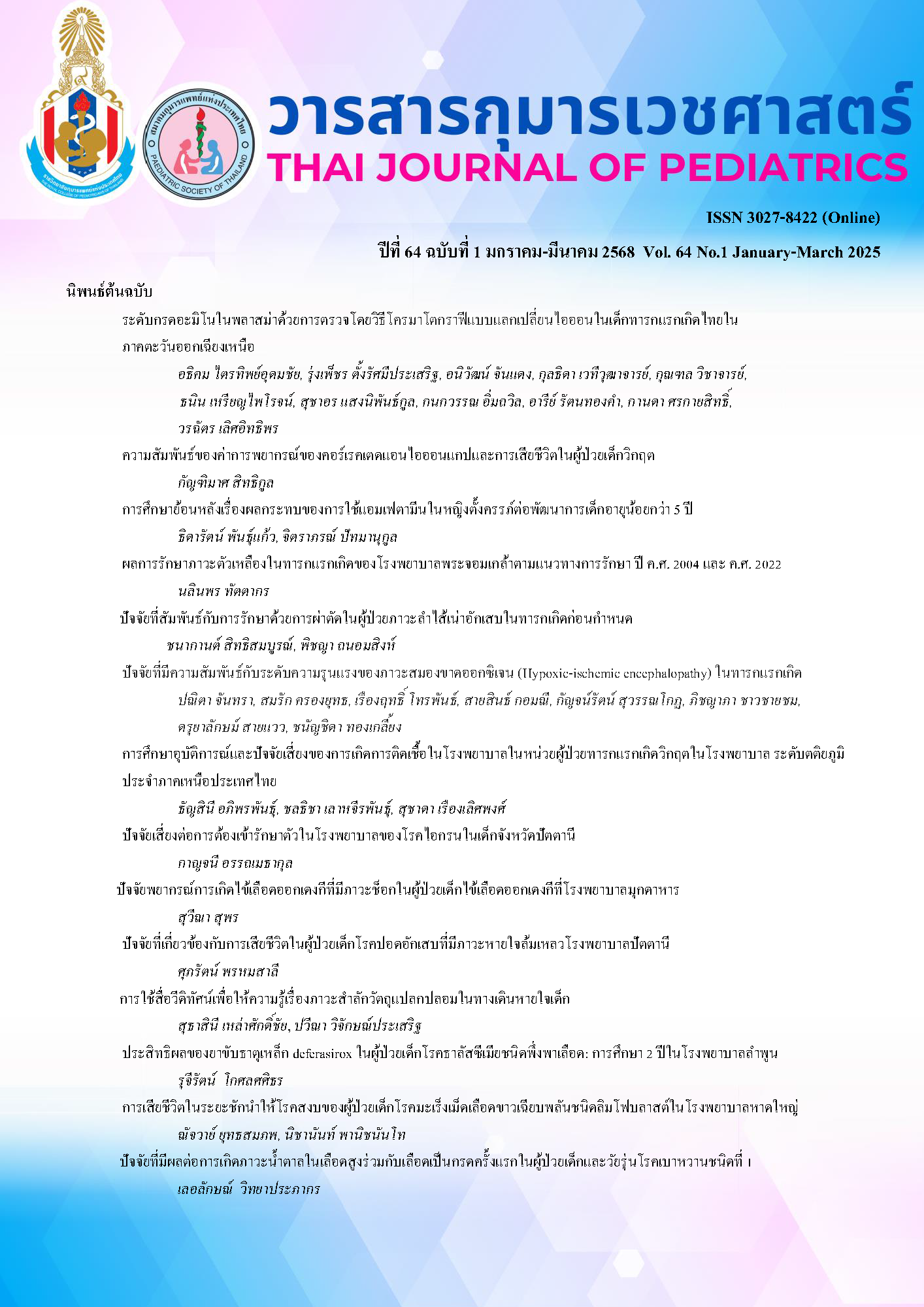ผลการรักษาภาวะตัวเหลืองในทารกแรกเกิดของโรงพยาบาลพระจอมเกล้าตามแนวทางการรักษาปี ค.ศ. 2004 และ ค.ศ. 2022
คำสำคัญ:
ภาวะตัวเหลืองในทารกแรกเกิด, แนวทางการรักษาผู้ป่วยตัวเหลือง , เกณฑ์ส่องไฟเพื่อรักษาตัวเหลือง, การถ่ายเปลี่ยนเลือดเพื่อรักษาตัวเหลืองบทคัดย่อ
ความเป็นมา: ครึ่งหนึ่งของทารกแรกเกิดครบกำหนดทั่วโลกพบว่ามีภาวะตัวเหลือง ตามที่สถาบันกุมารเวชศาสตร์แห่งอเมริกา ได้ปรับเปลี่ยนแนวทางการรักษาผู้ป่วยตัวเหลืองในทารกแรกเกิดในปี ค.ศ. 2022 และโรงพยาบาลพระจอมเกล้า จังหวัดเพชรบุรี ได้ปรับเปลี่ยนมาใช้ตั้งแต่วันที่ 1 มกราคม พ.ศ. 2566
วัตถุประสงค์: เพื่อศึกษาผลการรักษาภายหลังการเปลี่ยนการใช้แนวทางการรักษาภาวะตัวเหลืองในทารกแรกเกิด ปี ค.ศ. 2004 มาเป็นปี ค.ศ. 2022
วิธีการศึกษา: การศึกษาวิจัยเชิงพรรณนาย้อนหลัง โดยทำการทบทวนเวชระเบียนของทารกที่เกิดระหว่าง 1 มกราคม พ.ศ. 2565 – 31 มีนาคม พ.ศ. 2567 จำนวน 3,000 คน โดยแบ่งกลุ่มดังนี้ ผู้ป่วยที่เกิดก่อน 1 มกราคม พ.ศ. 2566 ใช้แนวทางการรักษาของปี ค.ศ. 2004 จำนวน 1,500 คน และหลัง 1 มกราคม พ.ศ. 2566 ใช้แนวทางการรักษาของปี ค.ศ. 2022 จำนวน 1,500 คน การวัดค่าตัวเหลืองด้วยการวัดระดับไมโครบิลิรูบิน จากการเจาะเลือดส้นเท้า
ผลการศึกษา: ผู้ป่วยที่ใช้แนวทางการรักษาของปี ค.ศ. 2004 จำนวน 1,500 คน และใช้แนวทางการรักษาของปี ค.ศ. 2022 จำนวน 1,500 คน มีจำนวนวันนอนโรงพยาบาล 3.37±1.25 และ 3.15±0.99 วัน (p value <0.01) อัตราการนอนโรงพยาบาลซ้ำด้วยเรื่องภาวะตัวเหลืองในทารกเเรกเกิด ร้อยละ 1.5 และร้อยละ 1.5 (p value 1.00) อัตราการส่องไฟ ร้อยละ 18.2 และ 15.3 (p value 0.40) และอัตราการรักษาด้วยการถ่ายเปลี่ยนเลือด ร้อยละ 0 และ 0.1 (p value 1.00) ตามลำดับ
สรุป: ภายหลังการเปลี่ยนการใช้แนวทางการรักษาภาวะตัวเหลืองในทารกแรกเกิด ปี ค.ศ. 2004 มาเป็น ปี ค.ศ. 2022 ที่เปลี่ยนเกณฑ์ค่าบิลิรูบินตามอายุของทารกเป็นชั่วโมง ที่ใช้ในการเริ่มและสิ้นสุด การรักษาด้วยการส่องไฟและการถ่ายเปลี่ยนเลือดซึ่งเกณฑ์ที่ใช้เริ่มต้นการรักษาจะสูงกว่าเกณฑ์เดิมในทุกอายุครรภ์ของทารกขณะคลอด พบว่ามีจำนวนวันนอนโรงพยาบาลน้อยลง แต่มีอัตราการนอนโรงพยาบาลซ้ำด้วยเรื่องภาวะตัวเหลืองในทารกเเรกเกิด อัตราการส่องไฟ และอัตราการรักษาด้วยการถ่ายเปลี่ยนเลือดไม่ต่างจากเดิม
Downloads
เอกสารอ้างอิง
Woodgate P, Jardine LA. Neonatal jaundice: Phototherapy. BMJ Clin Evid. 2015;5:1-21.
Okulu E. Neonatal jaundice: Recommendations for follow-up and treatment. Global Pediatrics. 2024;7:1-4.
Par EJ, Hughes CA, DeRico P. Neonatal hyperbilirubinemia: Evaluation and treatment. Am Fam Physician. 2023;107:525-34.
Kemper AR, Newman TB, Slaughter JL, Maisels MJ, Watchko JF, Downs SM, et al. Clinical practice guideline revision: Management of hyperbilirubinemia in the newborn infant 35 or more weeks of gestation. Pediatrics. 2022;150:1-27.
Keren R, Tremont K, Luan X, Cnaan A. Visual assessment of jaundice in term and late preterm infants. Arch Dis Child Fetal Neonatal Ed. 2009;94:317-22.
Alkén J, Håkansson S, Ekéus C, Gustafson P, Norman M. Rates of extreme neonatal hyperbilirubinemia and kernicterus in children and adherence to national guidelines for screening, diagnosis, and treatment in sweden. JAMA Netw Open. 2019;2:1-11.
Vidavalur R, Devapatla S. Trends in hospitalizations of newborns with hyperbilirubinemia and kernicterus in United States: An epidemiological study. J Matern Fetal Neonatal Med. 2022;35:7701-6.
Bhardwaj U, Kohli V, Thukral A. Management of hyperbilirubinemia in newborn infants 35 or more weeks of gestation: American Academy of Pediatrics, 2022. Indian Pediatr. 2023;60:63-6.
American Academy of Pediatrics subcommittee on hyperbilirubinemia. Management of hyperbilirubinemia in the newborn infant 35 or more weeks of gestation. Pediatrics. 2004;114:297-316.
Sarathy L, Chou JH, Romano-Clarke G, Darci KA, Lerou PH. Bilirubin measurement and phototherapy use after the AAP 2022 newborn hyperbilirubinemia guideline. Pediatrics. 2024;153:1-9.
Slusher TM, Abdulkadir I, Owa JA. Relevance of the 2022 american academy of pediatrics hyperbilirubinemia guidelines for an LMIC. Pediatrics. 2023;151:1-3.
Cahill C, Jegatheesan P, Song D, Cortes M, Adams M, Narasimhan SR, et al. Implementing higher phototherapy thresholds for jaundice in healthy infants 35 plus weeks. Hosp Pediatr. 2023;13:857-64.
García Vázquez J, González Vilaplana P, Portolés Morales M, Escrig Fernández R. Modification of the management of neonatal hyperbilirubinemia: Changes towards improving the quality of care. Anales de Pediatría (English Edition). 2024;100:378-9.
Chastain AP, Geary AL, Bogenschutz KM. Managing neonatal hyperbilirubinemia: An updated guideline. JAAPA. 2024;37:19-25.
Suphasit Y. Comparison of phototherapy rates and clinical outcomes between 2022 and 2004 American Academy of Pediatrics clinial practice guideline for management of neonatal hyperbilirubinemia. Thai J Pediatr. 2024;63:29-45.
ดาวน์โหลด
เผยแพร่แล้ว
รูปแบบการอ้างอิง
ฉบับ
ประเภทบทความ
สัญญาอนุญาต
ลิขสิทธิ์ (c) 2025 ราชวิทยาลัยกุมารแพทย์แห่งประเทศไทย และ สมาคมกุมารแพทย์แห่งประเทศไทย

อนุญาตภายใต้เงื่อนไข Creative Commons Attribution-NonCommercial-NoDerivatives 4.0 International License.



